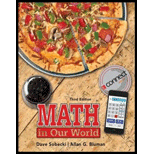
Concept explainers
The data below are the average daily temperatures in degrees Fahrenheit for every day of May 2012 in Honolulu.
(a) Build a frequency distribution, then use it to draw u histogram for the data. You can decide on the classes, but make sure there are less than 10.
(b) Use your histogram to analyze the data, including a comparison to the data in Problem 21.
76.2 77.0 76.0 76.4 78.3 78.2 76.6
76.0 76.6 75 4 77.9 79.5 77.7
75.8 76.8 74.5 78.0 78.3 77.7
75.1 76.3 73.9 77.7 77 8 77.5
75.7 76.0 74.3 77.7 78.5 77.0
21. The data below are the avenge daily temperatures in degrees Fahrenheit for every day of May 2012 in Las Vegas.
(a) Build a frequency distribution, then use it to draw a histogram for the data. You can decide on the classes, but make sure there are less than 10.
(b) Use your histogram to analyze the data.
77.9 74.5 83.8 90.3 93.9 68.5 81.5
78.3 77.4 85.3 84.5 90.1 75.3
77.8 80.2 85.7 80.5 83.0 82.4
75.3 83.0 86.5 83.1 78.5 85.0
74.6 84.7 86.3 87.8 63.6 89.1
Want to see the full answer?
Check out a sample textbook solution
Chapter 12 Solutions
Math in Our World
- Can you help explain what I did based on partial fractions decomposition?arrow_forwardFind the surface area of the regular pyramid. yd2arrow_forwardSuppose that a particle moves along a straight line with velocity v (t) = 62t, where 0 < t <3 (v(t) in meters per second, t in seconds). Find the displacement d (t) at time t and the displacement up to t = 3. d(t) ds = ["v (s) da = { The displacement up to t = 3 is d(3)- meters.arrow_forward
- Let f (x) = x², a 3, and b = = 4. Answer exactly. a. Find the average value fave of f between a and b. fave b. Find a point c where f (c) = fave. Enter only one of the possible values for c. c=arrow_forwardThe following data represent total ventilation measured in liters of air per minute per square meter of body area for two independent (and randomly chosen) samples. Analyze these data using the appropriate non-parametric hypothesis testarrow_forwardeach column represents before & after measurements on the same individual. Analyze with the appropriate non-parametric hypothesis test for a paired design.arrow_forward
- Should you be confident in applying your regression equation to estimate the heart rate of a python at 35°C? Why or why not?arrow_forwardGiven your fitted regression line, what would be the residual for snake #5 (10 C)?arrow_forwardCalculate the 95% confidence interval around your estimate of r using Fisher’s z-transformation. In your final answer, make sure to back-transform to the original units.arrow_forward
 Holt Mcdougal Larson Pre-algebra: Student Edition...AlgebraISBN:9780547587776Author:HOLT MCDOUGALPublisher:HOLT MCDOUGAL
Holt Mcdougal Larson Pre-algebra: Student Edition...AlgebraISBN:9780547587776Author:HOLT MCDOUGALPublisher:HOLT MCDOUGAL Glencoe Algebra 1, Student Edition, 9780079039897...AlgebraISBN:9780079039897Author:CarterPublisher:McGraw Hill
Glencoe Algebra 1, Student Edition, 9780079039897...AlgebraISBN:9780079039897Author:CarterPublisher:McGraw Hill Big Ideas Math A Bridge To Success Algebra 1: Stu...AlgebraISBN:9781680331141Author:HOUGHTON MIFFLIN HARCOURTPublisher:Houghton Mifflin Harcourt
Big Ideas Math A Bridge To Success Algebra 1: Stu...AlgebraISBN:9781680331141Author:HOUGHTON MIFFLIN HARCOURTPublisher:Houghton Mifflin Harcourt Functions and Change: A Modeling Approach to Coll...AlgebraISBN:9781337111348Author:Bruce Crauder, Benny Evans, Alan NoellPublisher:Cengage Learning
Functions and Change: A Modeling Approach to Coll...AlgebraISBN:9781337111348Author:Bruce Crauder, Benny Evans, Alan NoellPublisher:Cengage Learning



